Prewriting Strategies: 9 Proven Steps With Tips, Examples & Worksheets
Prewriting strategies are a number of techniques you can use to prepare yourself for the actual writing process. Writers who don’t use prewriting strategies purposefully set themselves up for failure. These writers either won’t finish their writing projects and if they do, their work won’t be logical to readers.
You can avoid such disasters by falling back on processes countless successful writers and authors use. In this article, we will discuss what prewriting is, and the 9-step techniques on how to pre-write successfully We will also go over some examples, and round off with worksheets that you can use to master this process.
👉Check Out Our Complete Guide: The Writing Process: 6 Steps With Tips, Examples, And Worksheets
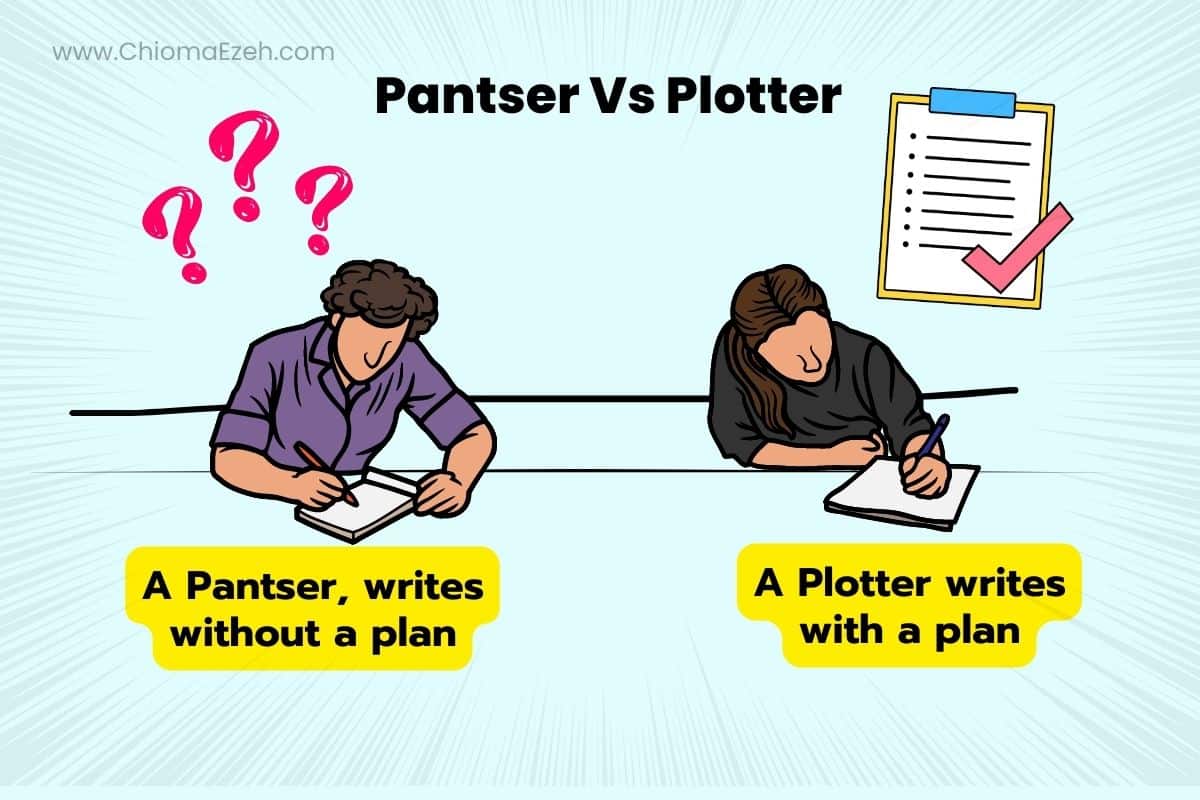
Let’s Talk
Are you a writer aspiring to pen a masterpiece that never fails to captivate? Look no further. Reach out to us and uncover how we can help you to take your writing to unprecedented heights!

What is Prewriting?
Prewriting refers to a set of techniques writers use to ready themselves to tackle a project. These steps are not set in stone, and a writer can use any combination of them.
Other people have written about your topic, which means you need to find out what they are saying. You don’t want an article or book that’s all over the place, so you might end up using a number of techniques to narrow down your focus. These are just some of the things that happen during the prewriting phase.
👉Head over to our guide to prewriting to learn more.
What is the Purpose of Prewriting?
Unlike plotters (writers who write with a plan), many writers who claim they can write without planning (called pantsers) still do some form of prewriting. Some reasons this stage of the writing process is important include:
- Prewriting helps you come up with ideas – you ideally want to know what you are going to write about before starting.
- Prewriting narrows down your focus – vague and generic ideas have the problem of being too broad and not being helpful to anyone.
- Prewriting forces you to find out what other writers in the same field have to say – the last thing you want to do is write about a topic that has been covered before.
- Prewriting helps you check if your topic is worth pursuing before wasting your time – you don’t want to work on an idea your target audience is not interested in reading about.
- Prewriting can help you check if your ideas are logical and coherent.
👉See our guide on 15+ reasons you should be prewriting for your next book!
The Prewriting Process Steps
Prewriting has several steps you can use. The good news is that you don’t need to follow every single step. You just have to go with what works for you. Here are some prewriting strategies you can use next time you have a writing project:
- Researching
- Brainstorming
- Listing
- Clustering (Mind Mapping)
- Freewriting
- Looping
- Journalistic Questioning
- Outlining
- Storyboarding
Any one of these steps can help you as you start a writing project. Use any combination that works for you.
#1. Researching
Researching is the first step for many writing projects. Start by reading other works on the topic, gathering resources, and taking notes. This helps you to get a sense of what your project should look like and can help spark ideas.
You can also start by talking to experts in the field or getting feedback from those who are knowledgeable about the topic. As a writer or author, try to think beyond what is already known and find unique ways of approaching the topic at hand.
Research is very important in the writing process. If you use incorrect information in your project or book, you may come across as ignorant and lazy to your readers. And this could potentially ruin your career, seeing as readers have no reason to trust anything else you write in the future.
👉Head over to our comprehensive guide on the research process to learn more tips on how to research for your book!
#2. Brainstorming
Your initial idea is not always the one you end up writing about. In addition, you might have a vague idea of what you want to write, but nothing specific. This is where brainstorming comes in.
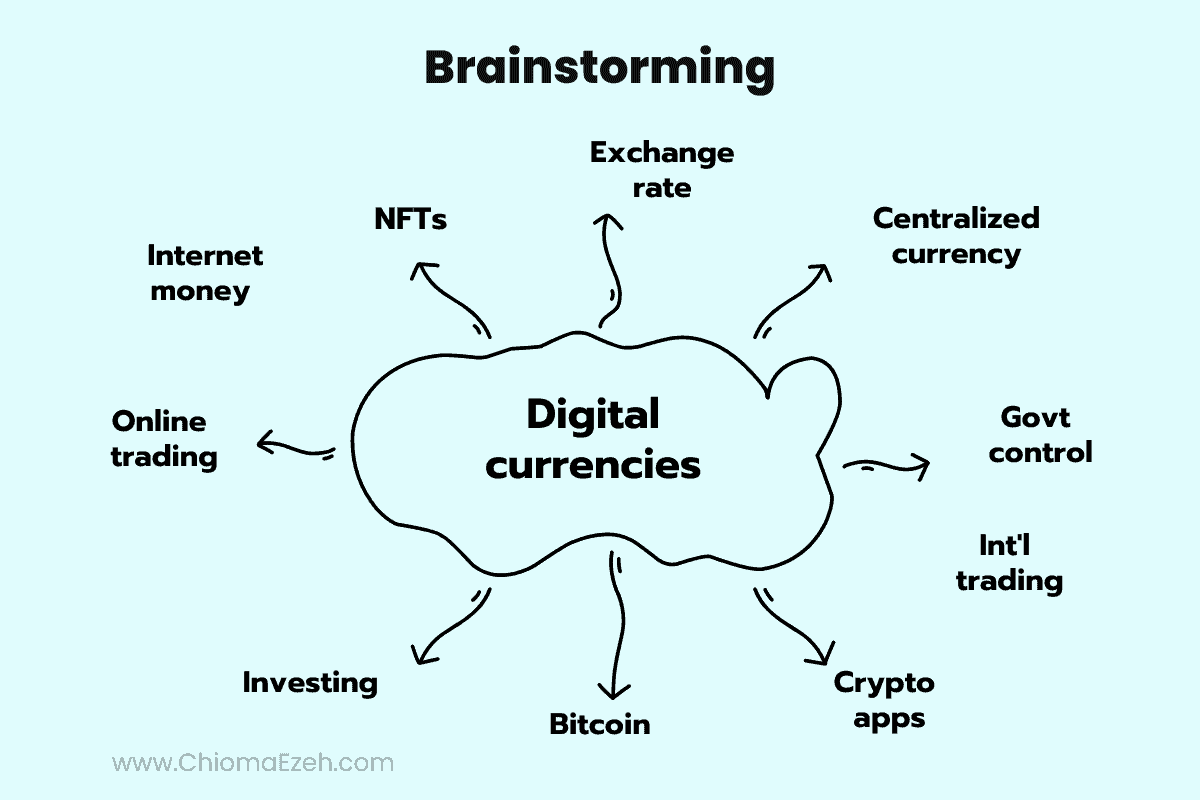
Brainstorming is a part of prewriting where you come up with as many ideas as you can. It doesn’t matter if many of the ideas are unreasonable, difficult, or not 100% related to your topic. The main aim here is to generate as many ideas as possible. Relax and don’t worry about being accurate yet.
Fiction authors might for instance brainstorm various endings for the same short story. Here are some guidelines you can follow when brainstorming:
- Be in an environment that is most conducive for work.
- Grab a paper and pen. Text editing software will also do.
- Set a timer.
- Write down anything that comes to mind.
Brainstorming is not compulsory. It might not be your cup of tea. That said, writers who don’t brainstorm are more likely to get stuck when their single idea doesn’t turn out to be as good as they thought it would be. In addition, some of the ideas you generate during this process can easily become subtopics and subheadings in your final piece.
Brainstorming Example
Here are some random ideas associated with digital currencies:
- Internet money
- Online trading
- Crypto
- International trading
- Centralized currency
- Government control
- Investing
- Bitcoin
- Crypto apps
- Exchange rate
Brainstorming is a helpful process that can ensure you have loads of ideas to choose from.
Exercise
Set a timer for ten minutes. Brainstorm the following until each timer goes off:
- The national unemployment rate.
- Your country’s president.
- Disney World
- Your favorite film.
- Game of Thrones
#3 Listing
Unless you are working with a detailed topic brief, your initial idea might be extremely broad. Listing helps you narrow down things and develop more ideas.
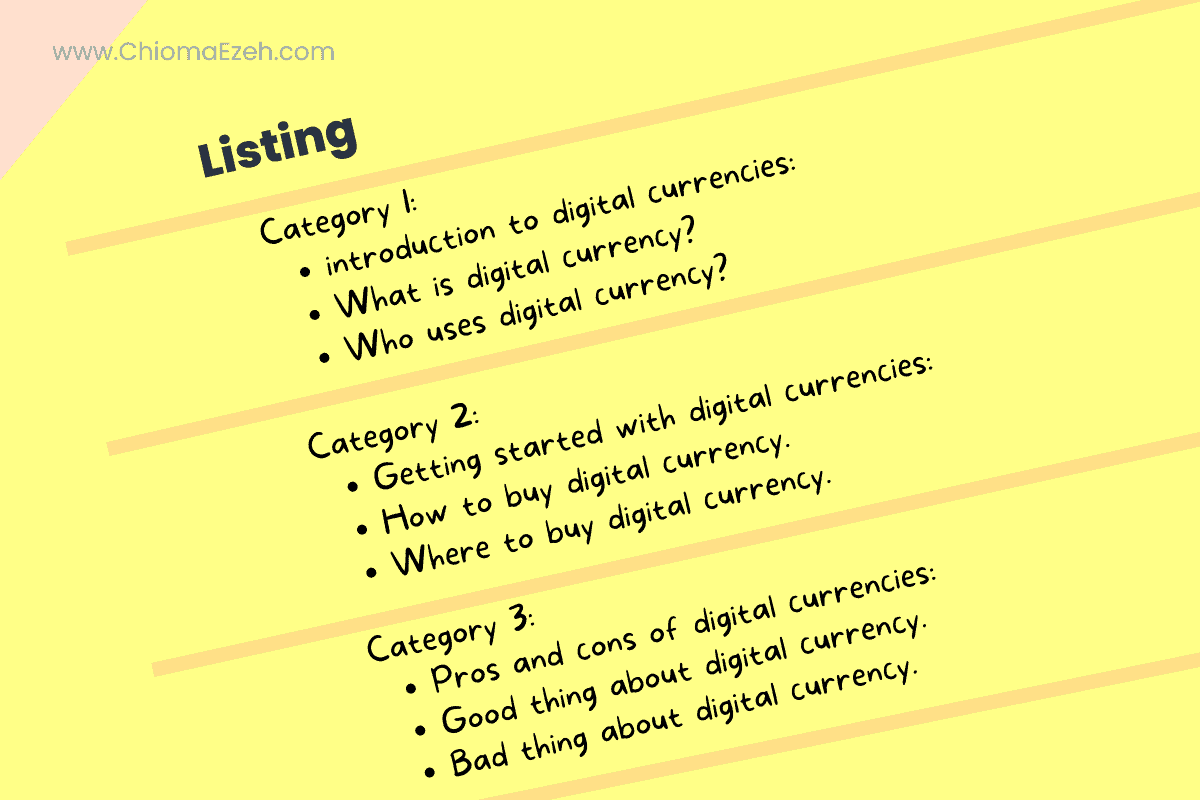
Listing involves noting down everything associated with your topic. These ideas can then be categorized by how related they are. These categories can then become the area your writing will focus on. The various ideas that fall under each category can become your research questions/subheadings.
Follow these steps when listing:
- Have a pen and paper or text editor at hand.
- Write down everything you can think of that’s associated with your topic.
- Put related ideas under one category.
- Write down a sentence about each idea.
While this step is not mandatory, it is good for narrowing down your research area and defining discussion points. A broad topic that is not broken down into manageable bits can lead to an article or book that is so broad, it helps no one.
Prewriting Listing Example
We’re first going to list down some ideas related to digital currencies, categorize them, and finally write sentences about some of them.
Digital currency ideas: What is digital currency? How to get digital currency? Good thing about digital currency. Bad thing about digital currency. Who uses digital currency? Where to buy digital currency.
Category 1, introduction to digital currencies: What is digital currency? Who uses digital currency?
Category 2, getting started with digital currencies: How to buy digital currency. Where to buy digital currency.
Category 3, pros and cons of digital currencies: Good thing about digital currency. Bad thing about digital currency.
The following are sentences to expand on the ideas from category 1:
What is digital currency: “Digital currencies are money-like assets that are managed over the internet.”
Who uses digital currency: “People weary of unstable governmental economic policies can use digital currencies.”
Exercise
- Write as many words as you can associate with the term “books.”
- Categorize the following words into related ideas: iPhone, Samsung, Windows, Nokia, headphones, charger, Windows, Android, and headphones.
- Choose any of the categories from 1 or 2, and write a sentence on each idea in that category.
- Use the listing techniques above on a topic of your own choosing.
- Listing is a good technique for writers who struggle to narrow down topics into manageable ideas.
#4. Clustering or mind mapping
Not all ideas you come up with will have anything to do with your topic. It’s very easy to be diverted into areas that have nothing to do with what you are working on when conducting research. Mind mapping can help you stay on track.
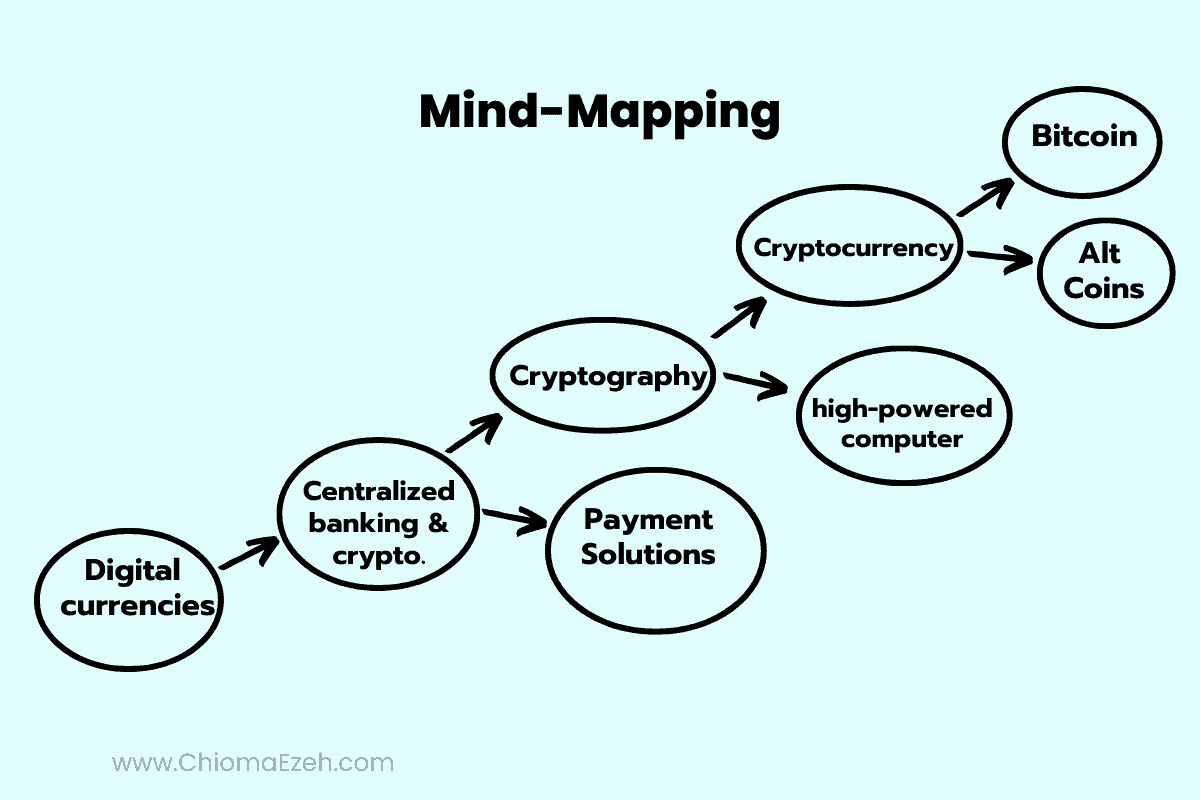
You can either use a chart or plain text editor/paper to create a mind map. Your main topic will be at the center. You can then write other ideas around the main topic while trying to establish links to the main topic. Your ideas can have sub-ideas, those sub-ideas can have their own sub-ideas, and so on.
Non-fiction writers will love mind maps because they can provide a wide pool of topics. On the other hand, fiction authors can use mind maps to generate subplot ideas.
Follow these steps to create a mind map:
- Create a chart or grab a large piece of paper.
- Write your main topic at the center.
- Write down other ideas around the topic, and draw lines to link them back to the main topic.
- Each idea can have sub-ideas linking back to it.
- Anything that cannot be linked to a parent idea should go.
It’s easy to become sidelined by ideas that have nothing to do with what you are writing about. This is especially true if you’re passionate about the subject. You’ll leave your readers puzzled at best, or make yourself look incompetent at worst if your writing is filled with vaguely related ideas. A mind map can help you avoid this.
Mind Mapping Example
Here is an example to demonstrate a mind map using our digital currency example.
Main topic: digital currency.
Ideas: centralized banking and crypto.
Ideas related to crypto: crypto mining and cryptography.
Idea related to crypto mining: high-powered computer.
Mind maps are a crucial technique that can help you focus your writing.
Exercise
- Create a mind map for financial literacy.
- Create a mind map for comedy.
- Create a mind map for music.
- Create a mind map for any idea that might occur to you.
#5. Freewriting
Some writers are not good at meticulous planning techniques such as mind maps. Their ideas only flow when they are writing. Freewriting is the best technique for such authors.
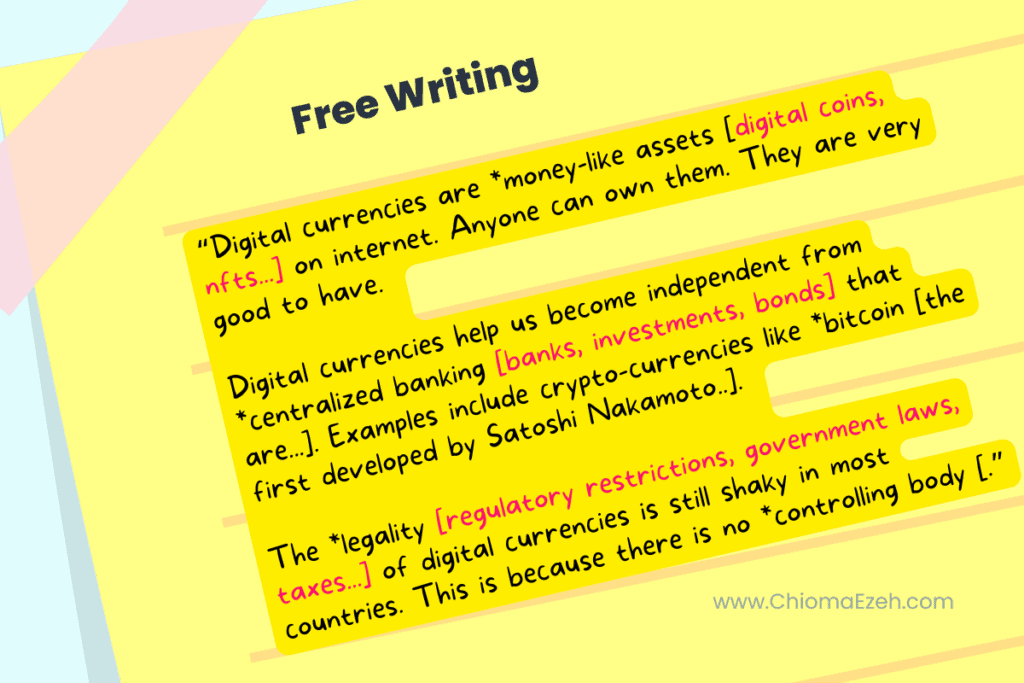
Freewriting is simply going with the flow. You can pick an idea, and then write as much as you can about it. Don’t worry about grammar or coherency just yet. You can then go back and pick out the good ideas when you are done. This process can be repeated as many times as you need to.
Fiction authors can also use this technique to get a feel for the story. You could pick a few random ideas, and write a page about each.
Here are some useful steps for people who prefer freewriting:
- Be in an environment conducive to writing.
- Have a pen and paper/text editor at the ready.
- Pick a topic.
- Set a timer.
- Write as much as you can about the topic until the timer goes off.
- Read through what you wrote, and highlight important ideas you might want to explore.
For writers who are not good with techniques such as mind mapping and listing, freewriting has many advantages. Not using it means you’ll end up relying on techniques that don’t work for you. This could ultimately negatively impact your final written piece.
Freewriting Example
The following paragraph demonstrates freewriting:
“Digital currencies are money-like assets on the internet. Anyone can own them. They are very good to have. Digital currencies help us become independent from centralized banking. Examples include cryptocurrencies like bitcoin. The legality of digital currencies is still shaky in most countries. This is because there is no controlling body.”
Here is the same passage, but with an asterisk (*) in front of an idea that can be further explored:
“Digital currencies are *money-like assets on the internet. Anyone can own them. They are very good to have. Digital currencies help us become independent from *centralized banking. Examples include *cryptocurrencies like *bitcoin. The *legality of digital currencies is still shaky in most countries. This is because there is no *controlling body.”
Freewriting is a powerful technique that can help you generate ideas you’ve never considered.
Exercise
Set a five-minute timer for each of the following exercises:
- Freewrite about soccer.
- Freewrite about your favorite book or movie.
- Freewrite about any musician of your choice.
- Freewrite about any topic of your choice.
#6. Looping
Looping is closely related to freewriting and shares some characteristics with mind mapping.
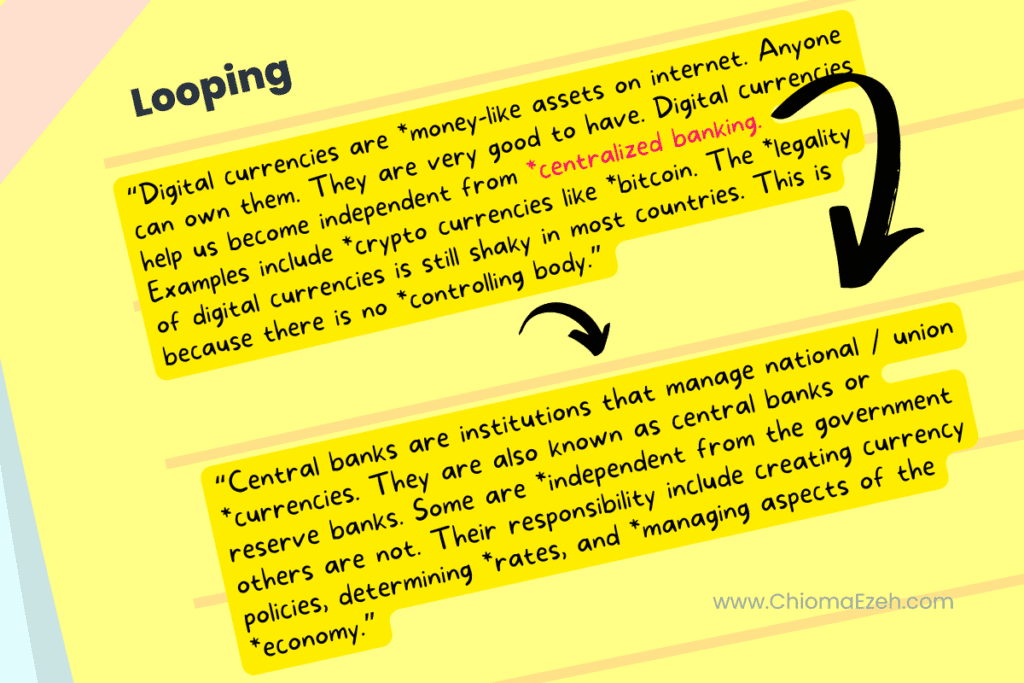
Looping is a process where you freely write ad expand your topic. You then pick an idea from what you wrote and start a new freewriting session. You can continue to pick yet another idea from the latest freewriting session and repeat the process as many times as necessary. A writer could easily end up doing five or more sessions.
Follow these steps if you want to loop:
- Pick a topic.
- Set a timer for five minutes.
- Write as much as you can.
- Pick an idea from what you just wrote.
- Reset the timer again.
- Start a fresh freewriting session using the idea from the first session.
- Repeat as many times as you need to.
Looping Example
Here is our example from the previous step:
“Digital currencies are *money-like assets on the internet. Anyone can own them. They are very good to have. Digital currencies help us become independent from *centralized banks. Examples include *cryptocurrencies like *bitcoin. The *legality of digital currencies is still shaky in most countries. This is because there is no *controlling body.”
Here is another paragraph if we were to start a new freewriting session using centralized banking:
“Central banks are institutions that manage national/union *currencies. They are also known as central banks or reserve banks. Some are *independent from the government others are not. Their responsibility include creating currency policies, determining *rates, and *managing aspects of the *economy.”
Exercise
- Freewrite a paragraph for each of the words highlighted with an asterisk.
- Pick any of your new paragraphs, and do at least two more freewriting sessions.
- Freewrite any topic of your choice.
- Apply what you just learned about looping on your session from 3.
#7. Journalistic questioning
Journalists write and provide information for a living. It should therefore come as no surprise they have great techniques when it comes to writing.

Journalistic questions seek to establish basic facts. This can include involved people, the reason the topic is important, and how the issue being addressed works. Using these questions will at the very least let you know if your idea is worth pursuing. You are good to go if you can answer all or most of these questions.
Journalists call their questions the 5w’s and 1h. They are:
- Who: Who cares, and who does the topic affect?
- What: What exactly is happening? What do you want to write about?
- Where: Which locations are relevant to what you are writing about? Is the topic country/region specific?
- When: In which time period is your project set? Which histories and time periods are relevant in order to get a fuller picture?
- Why: What is behind the topic? Why is it happening?
- How: How can people do anything about what you are writing?
You are in trouble if you cannot answer many of these questions. For instance, failure to answer “who” probably means you don’t have a target audience, failure to answer “why” might mean you haven’t properly done your research, failure to answer “how” comes across as if you don’t have solutions, etc.
Journalistic Questioning Example
Here is how we might answer the 5w’s and 1h for our digital currency example:
- Who? People who want to learn more about digital currencies.
- What? There is a growing interest in digital currencies. This article will provide some basics.
- Where? This is relevant to people in places where they don’t necessarily trust banking institutions.
- When?: This article is relevant for 2022. The financial crisis of 2008 is an example of how financial institutions can collapse, taking the currency down with them.
- Why?: There is a growing mistrust of governments and financial institutions. People need alternative methods of protecting their wealth.
- How?: People can educate themselves using this article, before signing up for various digital currency services.
The 5W’s and 1H are a set of questions that can make or break your topic.
Exercise
- Read a newspaper article. See if you can identify the 5w’s and 1h.
- Think about your favorite book. Try to come up with the 5w’s and 1h for the book.
- Answer the journalistic questions if your topic was: “Write a 750-word review of your favorite film to convince people to go and watch it.”
- Answer the journalistic questions for any topic of your choice.
#8. Outlining
Knowing what exactly you are going to talk about from beginning to end is one of the main goals of prewriting. That’s why after you’ve researched, brainstormed, asked yourself journalistic questions, etc., one of the last steps is creating an outline.
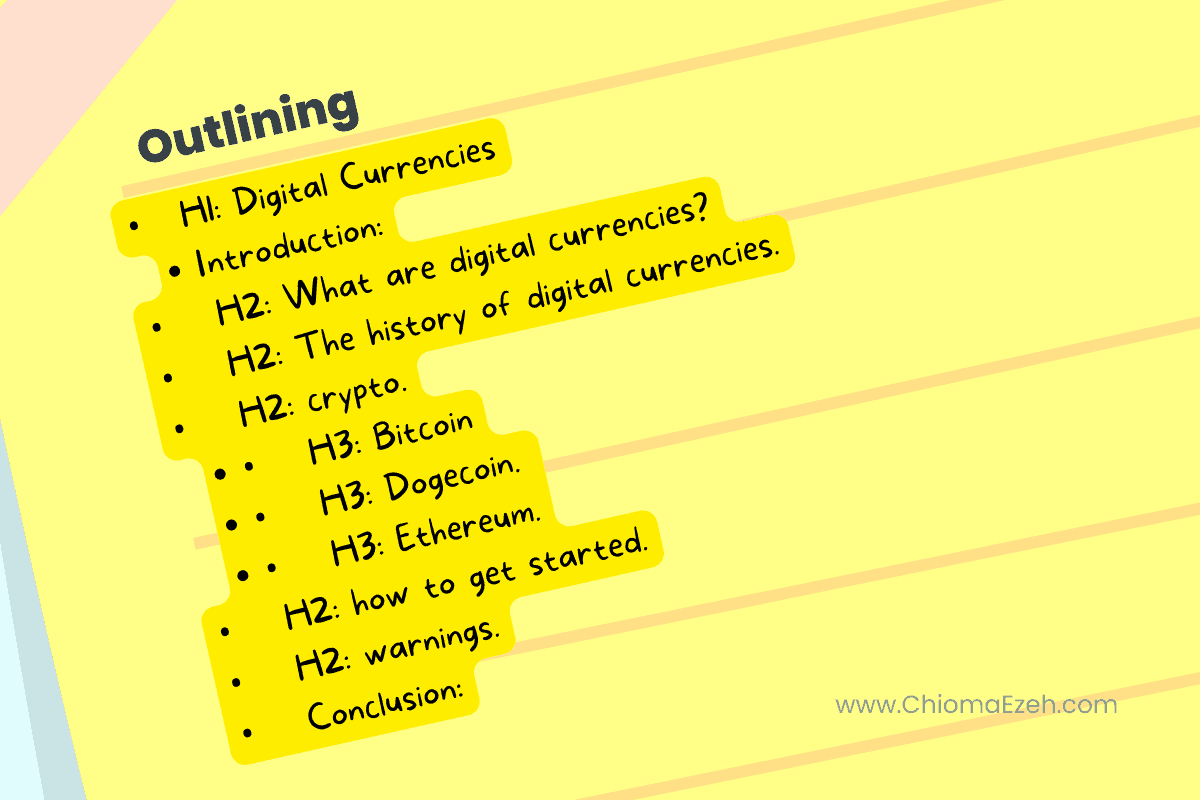
An outline is a description of everything you are going to cover in your book or article. Make it as detailed as you want it to be. Some writers will outline every single point and paragraph, while others will just create headings and subheadings. Others might just jot down the introductory points, middle, and conclusion.
Novelists will find outlines extremely useful. They can help you plan and view the entire novel before starting your pros.
Here are some guidelines you might find useful when outlining:
- Write your main idea at the top.
- Create subheadings.
- List what you want to cover under each subheading in bullet form.
- Be as detailed as you think is necessary.
Not having an outline can make things difficult for you when writer’s block strikes. The last thing you want is to have your mind go blank when you have a looming deadline. Outlines also help you to check if your ideas are logical and smoothly flow from one to the next before you start writing.
Outlining Example
Here is a sample outline for our digital currency article:
- Introduction: Introduce digital currencies [Lead with shocking statistic]
- H2: What are digital currencies?
- H2: The history of digital currencies.
- H2: crypto.
- H3: Bitcoin
- H3: Dogecoin.
- H3: Ethereum.
- H2: how to get started.
- H2: warnings.
- Conclusion: [Summarize article]
Outlining is a process that can be your best friend when your mind goes blank.
Exercise
Create outlines for the following topics:
- Covid-19 symptoms.
- The 2022 FIFA World cup.
- Pop music.
- Any topic of your choice.
#9. Storyboarding
Visually oriented people sometimes struggle with techniques such as freewriting and looping. Storyboarding is the best choice for these writers.

Storyboarding is a visual prewriting technique that has its foundations in film production. Authors of fiction will find it extremely useful. You can build a board with various events you want to cover. You can then connect these events in sequential order.
You can either use a physical board or rely on software such as Trello.
Storyboarding Example
We could have a board called Crypto as part of our digital currency article. We can then create individual cards for each point we want to cover about crypto. So our cards might have titles like:
- History of crypto
- Most valuable cryptocurrency
- Benefits of crypto
- Disadvantages of crypto
Exercise
- What might you call a board that has cards with titles such as carbohydrates, vitamins, proteins, hydrated, and organic?
- Come up with the names of cards you might add to a board called “online marketing.”
- Come up with a minimum of five board names.
- Create at least three cards for each of the boards from 3.
Tips For Developing Your Prewriting Process
If we could sum up the prewriting process in one sentence, it would be: “Be ready to write.” That is all that matters. Most of the prewriting strategies covered in this guide are not compulsory. But you can improve the quality of your writing by following many of them.
Journalistic questions and some sort of outline are the two most crucial steps in prewriting. Leaving them out can mean danger down the road.
FAQs on Prewriting Strategies
Should I follow every single strategy in the prewriting stage?
No. Very few writers follow every step. Some only follow one or two. Others mix them up to create their own unique process. That said, ignoring things like research, outlining, and journalistic questions will only create problems for you down the road.
Are the prewriting strategies to be followed in order?
You don’t need to follow all nine steps. Similarly, those you choose to follow, don’t need to be completed in any specific order. One writer might choose to create a mind map before freewriting. Another might create a storyboard first, then use cards from the board to generate looping ideas. Writers knowledgeable about their chosen topic might start by creating an outline, and finish by conducting research.
Can I create a good piece of writing without prewriting?
Some writers prefer working without a plan. In fact, the harder they plan, the more restricted they feel. These writers are sometimes known as pantsers in book writing. That said, even pantsers do some planning. They might do preliminary research. A pantser might develop a brief outline that has only the beginning, middle, and end. Writers who skip the prewriting process entirely, and still manage to produce outstanding work, are exceedingly rare.
Final Notes On Prewriting strategies
Prewriting is the first stage of the writing process. This step is concerned with making sure you are prepared to start writing.
Research, mind mapping, listing, outlining, looping, and freewriting are just some of the prewriting techniques available to you. While none of these are compulsory, a good writer will always make use of some. Researching and asking journalistic questions are two things a serious writer will consider doing.


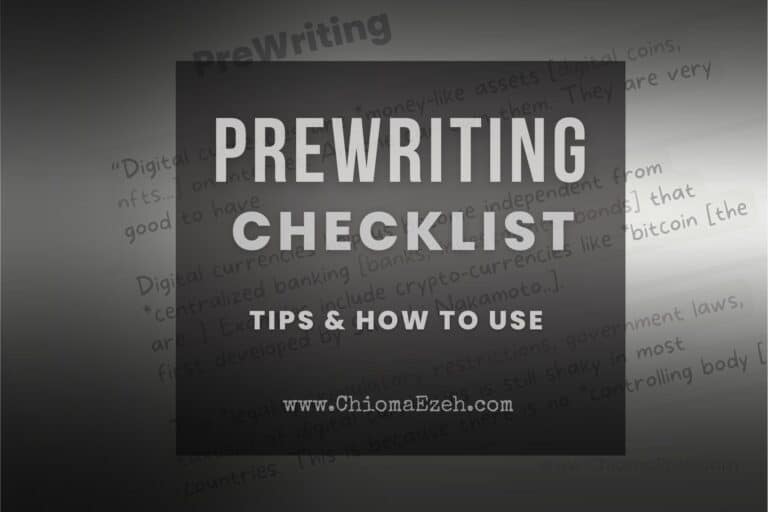
![What Is Third Person Point of View? [Definition & Examples]](https://chiomaezeh.com/wp-content/uploads/2023/03/third-person-point-of-view-1-768x512.jpg)


